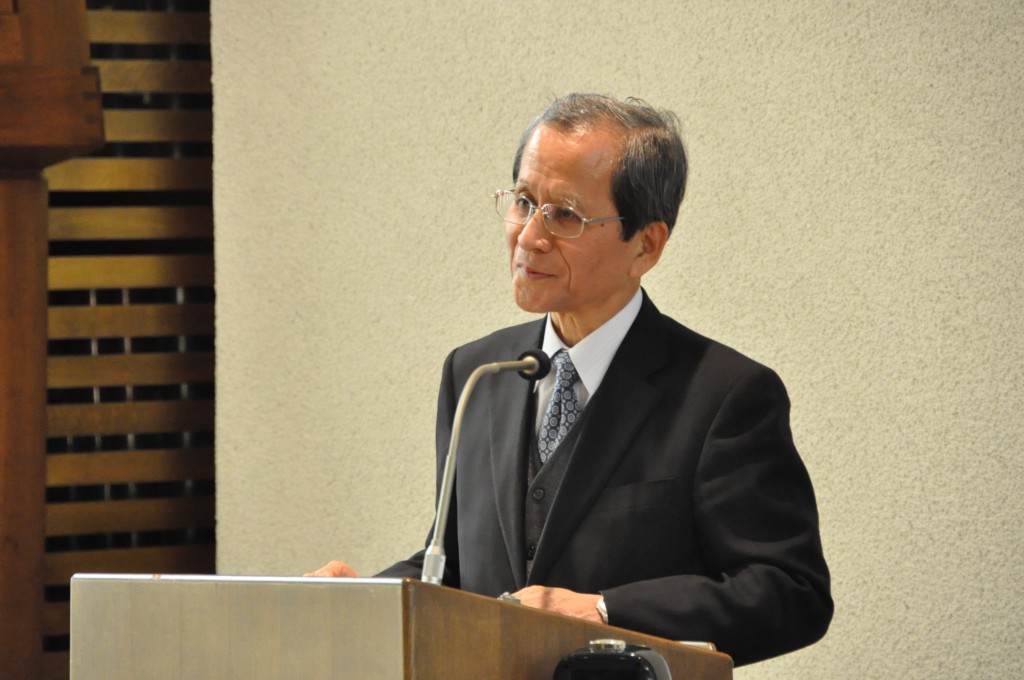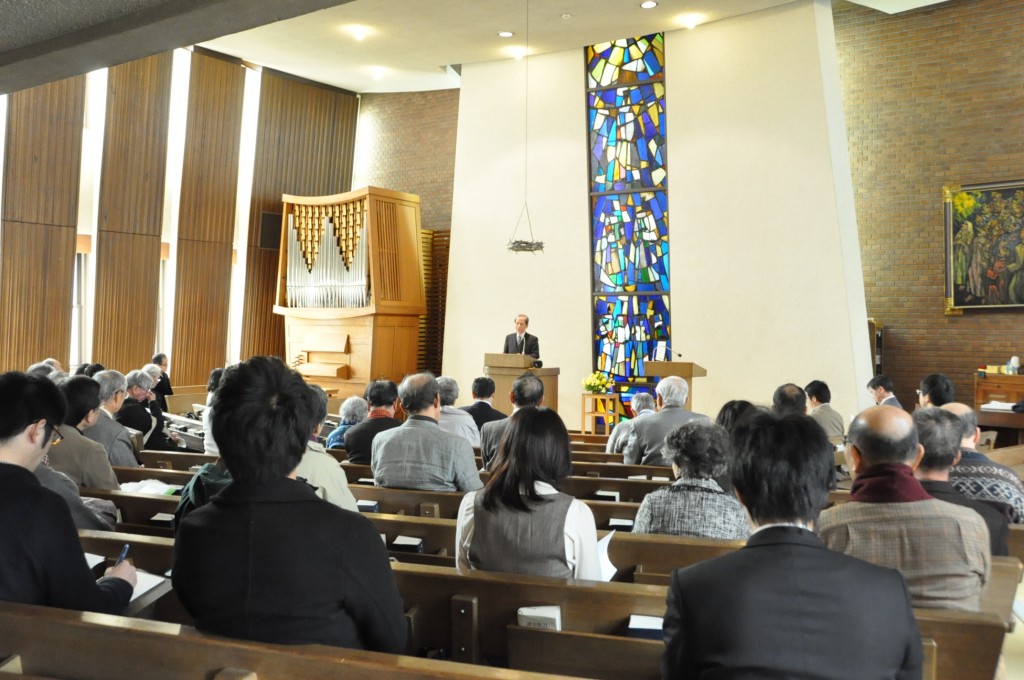Center for Interdisciplinary Study of Monotheistic Religions(CISMOR)Doshisha University
> Public Lectures > What is the Islamic Republic of Iran?Public Lectures
Public Lectures
What is the Islamic Republic of Iran?
| Date: |
2012/11/24 13:30− 15:30 |
|---|---|
| Place: | Divinity Hall Chapel, Imadegawa Campus, Doshisha University |
| Lecture: |
Kinich Komano ( Former Ambassador of Japan to Iran) |
| Summary: | |
|
In this lecture, Mr. Kinichi Komano analyzed the Islamic republic regime in Iran from three perspectives with a view to deepening understanding of this country. First, the process of the establishment of the current Islamic republic regime in Iran was largely affected by various incidents that this country had experienced over the past one-third century, as well as the ideology espoused by Ayatollah Khomeini. The regime is supported by the religious community, the Revolutionary Guards, the government, and “citizens.” The Iranian religious community was heavily dependent on the presence of Ayatollah Khomeini, and since his death, the community has basically performed the role to maintain the regime established during Khomeini’s reign. In addition, the religious community is in possession of judiciary power, one of the three pillars of the Iranian government. The Revolutionary Guards are representative of the revolutionary organizations that fought the Iran-Iraq War. They recruited volunteers to fight the war, while providing support behind the lines as well. Today, the Revolutionary Guards are supporting the current regime in military, security, economic, and political areas under the control of the supreme leader. The government is in a position to use an immense amount of money, mostly earned from oil. The government is the largest employer and the largest think tank in this country. Therefore, they are capable of developing policies at will. The president, as the head of the government, has huge authority, which makes his decision highly important. Lastly, the term “citizens” does not necessarily refer to the entire Iranian population, but it only means people who serve on the battlefield during war, join Friday prayers, and willingly take action when ordered by the supreme leader. As the survival of the current regime is dependent on the loyalty of these citizens, both the supreme leader and the president are keen to win their hearts. Secondly, we should pay close attention to the Iranian view of the world, its religious outlook, and its identity. The supreme leader and the president of Iran has repeatedly stated the view of the world that, unlike the U.S. and other Western countries, which have been in economic and ethical decline, Iran enjoys independence and great economic and industrial prosperity, which can be attributed to their faith in Islam and the adherence to the principle of revolution. Western countries cannot stand the success of Iran, and they are trying to destroy Iran by all means. Therefore, Iran has to remain faithful to the ongoing principle and continue maximum effort to stand against the attacks of the West. Speaking of the Iranian religious outlook, it should be noted that Iran is a major Shi’a state. Unlike the Sunni sect, the Shi’a sect is characterized by esoteric teachings, with its emphasis placed not only on law but also on internal spirituality. In addition, Shi’a Muslims have a stronger tendency to seek a direct connection with God. For Muslims in Iran, the 12 imams who descended from Ali, the son-in-law of the Prophet Muhammad, are as important as God and the Prophet. Especially, they yearn for the future reappearance of the 12th hidden imam, and believe that the world is placed under the rule of Muslim scholars until his reappearance. The belief in the reappearance of the imam has caused a conflict between the pro-president group and the religious community. Thus, the disagreement over religious views constitutes a part of the power struggle between pro-president and anti-president parties in Iran. As for Iranian identity, it is important to note that Iran is a multiethnic country with a long history behind it, and had already developed sophisticated culture and civilization prior to the introduction of Islam. Iranian nationalism is based on this tradition. At the same time, Islam’s predominance is obvious in Iran, as this country converted to Islam in the 7th century and has since continued to build society based on the teachings of Islam. Iranian nationalism and Islamism have often given rise to domestic conflicts, including the power struggle between the pro-president and anti-president parties. Thirdly, it should be noted that power struggles have been an inevitable part of Iranian society due to the difference in religious outlook and identity among Iranian citizens, as well as the ideological antagonism between the supreme leader and the president on the one hand and the reformist group seeking to build amicable relationships with the West on the other. In addition, against the backdrop of the failure of the private sector to effectively drive economic growth, the government and the president have gained greater power and authority, which has led to repeated power struggles. In the last presidential election, the conservatives under the control of the supreme leader acted in unison with the pro-president party in the face of the rising popularity of the reformist group among citizens, and together, they completely suppressed the organizational activities of the reformist group though the latter maintained a high level of popularity among citizens. After defeating their common enemy, however, the pro-president party parted with the conservative opponents, which gave rise to conflicts among those who succeeded in an attempt to upset the pro-president party to some extent. However, this situation did not lead to the collapse of the current Iranian regime. The Iranian religious community, whose most important mission is to maintain the current regime, is regularly providing support and encouragement to “citizens” so that they can mobilize them whenever necessary to suppress opponents by force. In addition, the religious community, with its judiciary power, along with security organizations, acts to completely eliminate opposition forces, as necessary. While this mechanism works effectively to trigger action to maintain the current regime, the Iranian government also has the flexibility to compromise its principles if doing so is necessary to maintain its regime. For example, the main purpose of Iran’s involvement in the war against Iraq was to overthrow the Saddam Hussein regime, but when the survival of the Iranian regime itself was threatened by the shortage of funds and volunteers as well as the growing likelihood of the entry of the U.S. into the war, the Iranian government flexibly abandoned the purpose and agreed to a ceasefire. To conclude the lecture, Mr. Komano referred to the Iranian nuclear problem and indicated the possibility of the Iranian government making a drastic concession on this matter depending on the development of the situation. Following the lecture, a closed-door workshop was held in which a lively discussion took place over the nuclear problem and the relationship between Iran and Israel. (Tomoki Asaka, Research Fellow, CISMOR, Doshisha University) |
|
|
*Admission Free, No Reservation Necessary. Hosted by: CISMOR Co-hosted by: School of Theology, Doshisha University |
|
|
Program(Japanese) |
|

